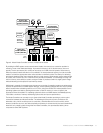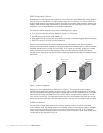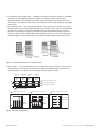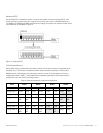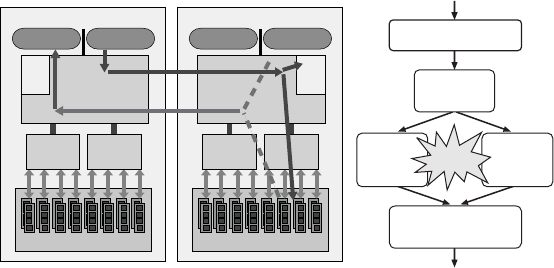
18 BladeSymphony 1000 Architecture White Paper www.hitachi.com
L3 Cache Copy Tag
The data residing in caches and main memory across Intel Itanium Server Blades are kept in sync by
using a snooping cache coherency protocol. When one of the Intel Itanium processors needs to access
memory, the requested address is broadcast by the Hitachi Node Controller. The other Node
Controllers that are part of that partition (SMP) listen for (snoop) those broadcasts. The Node Controller
keeps track of the memory addresses currently cached in each processor’s on-chip caches by
assigning a tag for each cache entry. If one of the processors contains the requested data in its cache it
initiates a cache-to-cache transfer. This reduces latency by avoiding the penalty to retrieve data from
main memory and helps maintain consistency by sending the requesting processor the most current
data. In order to save bandwidth on the processors’ front side bus, the Node Controller is able to use
the L3 Cache Copy Tags to determine which memory address broadcasts its two local processors
need to see. If a requested address is not in the processors’ cache, the Node Controller filters the
request and does not forward the request to the local processors. This process is illustrated in
Figure 10.
Figure 10. L3 cache copy tag process
Intel Itanium I/O Expansion Module
Some applications require more PCI slots than the two that are available per server blade. The Intel
Itanium I/O Expansion Module provides more ports, without the expense of additional server blades.
Using the Itanium I/O Expansion Module with the Intel Itanium Server Blade can increase the number of
the PCI expansion-card slots that can be connected to the Intel Itanium Server Blade. The Itanium I/O
expansion module cannot be used in with the Intel Xeon Server Blade.
The Intel Itanium I/O Expansion Module increases the number of PCI I/O slots to either four or eight
slots depending on the chassis type. The type A chassis enables connection to four PCI I/O slots
(Figure 11), and the type B chassis enables up to eight PCI I/O slots (Figure 12).
Main Memory
Node 0
Node
Controller
L3 C
Copy
Tag
Itanium2 Itanium2
Main Memory
Node 1
Node
Controller
L3 C
Copy
Tag
Itanium2 Itanium2
Memory
Controller
Memory
Controller
Memory
Controller
Memory
Controller
(1)
(2)
(4)
(3)’
(3)
(4) Memory data transfer
or
Cache data transfer
(3)
Memory
access
(3)’ Cache
consistency
control over
remote nodes
(2) Memory
address
broadcasting
(1) Cache consistency
control within a local node
Parallel
Processing








